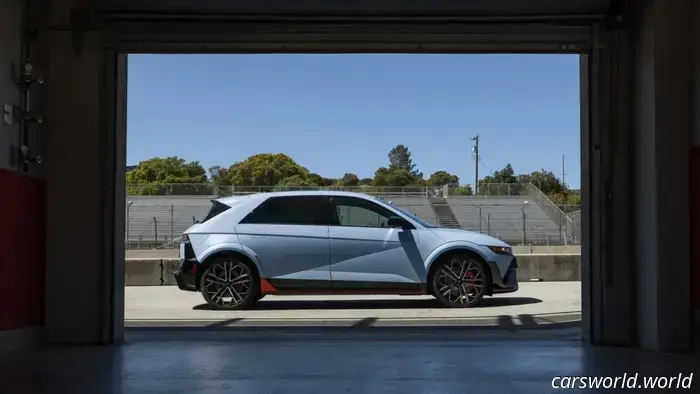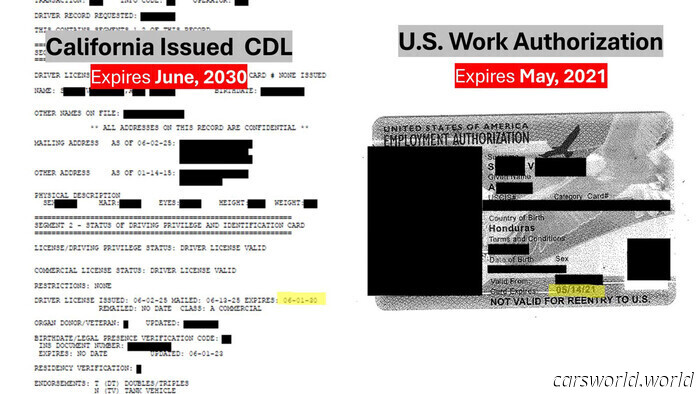
Changing Brake Pads on a Hyundai Ioniq 5 N Needs a Professional Mechanic's Access.
**Hyundai**
The latest car news and reviews, no nonsense.
Our free daily newsletter delivers the most relevant stories straight to your inbox every weekday.
A 2025 Hyundai Ioniq 5 N owner recently expressed frustration on Reddit about the inability to change his brake pads without specialized computer tools. It may seem absurd, but this is how car ownership operates in 2025. We researched the issue further and reached out to Hyundai for clarification—it’s a frustrating situation.
While needing to interface with computers to service a vehicle isn't exclusive to this Korean automaker, I found myself delving deep into Hyundai maintenance topics, so that will be our focus for now.
For casual readers: Replacing brake pads and rotors is basic automotive maintenance. Electric cars don't require this as frequently (thanks to regenerative braking), but even EV brake pads have a limited lifespan. On most vehicles, part of the replacement process involves disconnecting or retracting the parking brake, which typically secures the rear wheels. Many modern cars, including all EVs, utilize an electronic parking brake controlled by a computer signal, rather than a manual system. This is what prompted Redditor u/SoultronicPear's warranted frustration.
Another important point: Since electronic parking brakes are so common, many diagnostic tools (basic OBD scanners) can issue a retract-brake command to a car’s ECU. However, you need one that has bi-directional test capabilities. Keep this point in mind; it will be important later.
Curious if your vehicle has an electronic or mechanical parking brake? It’s simple to identify—if it has a button or switch (on the left), it's electronic. Parking brakes with large, satisfying handles (on the right) are mechanical.
It appears that the original Reddit poster's Ioniq 5 N did not respond to any affordable scanner options, leading them on a quest to find commercial-grade repair equipment, ultimately without success.
To access the diagnostic systems of a Hyundai EV, you need either the manufacturer's proprietary dealership hardware and software (known as GDS, available for purchase at around six grand) or a third-party aftermarket system compliant with the J2534 program. J2534 is a standardized interface established by the SAE and required by the EPA, ensuring ECUs from different brands can communicate for independent repairs.
Bi-directional scanners are available for a few hundred dollars. For example, the TOPDON ArtiDiag900 claims to control electronic parking brakes, but it likely would not pass Hyundai’s software authentication checks.
Hyundai endorses J2534 and suggests three devices for interfacing with its vehicles: CarDAQ Plus 3 (approximately $2,000), MTS 6531 (also about $2,000), and d-briDGe PRO (around $800). The company states, “…under no circumstances do we recommend the use of a non-approved J2534 device.” Additionally, a subscription to Hyundai’s J2534 Diagnostic Tool Software is required, costing $60 weekly (or less for longer periods). All this information is available in .PDFs linked from Hyundai’s tech portal.
After spending around $2,000 on tools, you should theoretically be able to service your own Hyundai Ioniq brakes. However, for DIY enthusiasts, this is still not possible. At the top of one of Hyundai’s numerous technical documents is a notice stating: “Access to Bi-Directional Tests and Special Functions require Diagnostic Professional or Vehicle Security Professional credential from NASTF.”
NASTF stands for the National Automotive Service Task Force, which aims to identify and resolve gaps in service information, tool access, and training between OEMs and independent repair facilities. It also governs aspects like lock coding and car credential management. To obtain scan-tool validation as a member, one must be a licensed mechanic.
With this final barrier, it is confirmed that a DIY enthusiast cannot perform brake maintenance on a Hyundai Ioniq 5 N.
I assume many of you reading this share the same sentiment I had—it seems reasonable to have regulations regarding sensitive data like your car keys, but it feels unjust that you shouldn't be able to change the brake pads on a car you own. Or as Randy Marsh would say: “I’m sorry, I thought this was America!”
This image illustrates the rear brakes of the Ioniq 5. Notice the small hook indicated by the orange arrow? That's the parking brake engager. If one were changing brake pads and rotors on this vehicle, they would likely disconnect this cable to remove the caliper, then push the piston into the caliper, and finally reconnect the cable and manually adjust its tension. Modern cars continue to have this capability, but it can’t be accessed without computer control.
I also reached out to Hyundai directly about this situation. Here’s their response:
“Hyundai is dedicated to providing safe, secure, and accessible service solutions for our dealer network and independent repair shops. For vehicles like the Ioniq 5






Other articles
 17,000 Immigrants in California May Soon Forfeit Their Commercial Driver's Licenses | Carscoops
California must take action now or face the possibility of losing $160 million in federal road funding.
17,000 Immigrants in California May Soon Forfeit Their Commercial Driver's Licenses | Carscoops
California must take action now or face the possibility of losing $160 million in federal road funding.
 Here's Why Modern Headlights Are Extremely Frustrating
This video discusses the reasons behind the extreme brightness of headlights today and the intricate history that led to this situation.
Here's Why Modern Headlights Are Extremely Frustrating
This video discusses the reasons behind the extreme brightness of headlights today and the intricate history that led to this situation.
 2026 Nissan Pathfinder Features an Unseen Hood View That You Will Truly Utilize | Carscoops
Nissan's three-row SUV features a more aggressive design, advanced cabin technology, and several thoughtful enhancements to maintain appeal, but is it sufficient?
2026 Nissan Pathfinder Features an Unseen Hood View That You Will Truly Utilize | Carscoops
Nissan's three-row SUV features a more aggressive design, advanced cabin technology, and several thoughtful enhancements to maintain appeal, but is it sufficient?
 The latest in car news and reviews, no nonsense
Our free daily newsletter brings you the most important stories straight to your inbox every weekday.
In October, the announcement of Assetto Corsa Rally thrilled rally racing enthusiasts. It came unexpectedly and at a timely moment, coinciding with the end of Codemasters’ long-running series of rally games dating back to Colin McRae. However, Assetto Corsa Rally differs from those titles and is designed for a distinct audience. While Dirt Rally was known for its challenging gameplay, ACR aims for an even harsher level of realism. If that sounds appealing, you can experience it today, as it has just launched on Steam Early Access at a limited-time price of $24.
The publisher 505 Games provided The Drive with a review code, and I’ve spent the last few days familiarizing myself with it. At launch, ACR features 10 vehicles from the early ’70s up to the present, representing various drivetrain types. There are four complete stages set in Rally Alsace and Wales, which can also be divided into smaller segments if desired. Most importantly, these stages consist of real-life dirt and tarmac that have been laser-scanned for the game. According to developer Supernova Games Studios, this is a first in the genre.
Speaking of Supernova, while ACR builds on the physics technology created by Kunoz Simulazioni for Assetto Corsa Evo, the team has utilized Unreal Engine 5 for its graphics. This raised concerns initially, as gamers familiar with the early days of EA Sports WRC can attest to the significant shader stutters in that title, which severely interrupted gameplay, especially at the start of stages. Fortunately, I’m happy to report that ACR not only looks much better than WRC at this early stage, but it also performs better.
Driving that classic Alfa GTA Junior is a real pleasure once you master it! Plus, it’s beautiful. 505 Games
I did experience a few minor stutters early on, but they were so negligible that they didn’t disrupt my gameplay and disappeared quickly. My setup—AMD Radeon RX 9070 GPU paired with a Ryzen 7 5800X3D CPU—handled the game mostly at high settings, with some features like effects and foliage set to ultra at a 1440p resolution. This resulted in a frame rate fluctuating between the high 60s and low 80s, which is quite good for a UE5 game, especially one that looks this impressive on mid-range hardware.
There are moments in this game that are truly breathtaking. I recommend utilizing the dynamic time of day feature in a custom rally and increasing the speed to 60x, aptly labeled “Unrealistic.” Witness the sunrise in Wales against a wet track, as sunlight filters through the trees, illuminating the pines with a morning glow and reflecting off puddles. This game is visually stunning, as all rally titles should be, embodying the beauty of nature as you race through it on the edge of control. It’s difficult to divert your gaze from the action in front of you.
Navigating this game can be quite challenging because, in terms of handling, it is the most demanding rally sim I’ve played in quite a while. I used a controller, which the game supports, but Supernova advises against it. This makes sense, as Assetto Corsa has always focused on an authentic wheel-and-pedals experience. However, ACR is still quite playable with a pad, and I’d argue it feels more natural on a controller than Evo or any other game in this franchise.
505 Games
Caution is essential, though. If you're accustomed to Codemasters' titles, the first thing you’ll notice is the reduced grip level. It’s advisable to test its limits using a low-powered front-wheel-drive hatchback first, like the Peugeot or Hyundai junior-class cars, which exhibit heavy understeer, before advancing to a high-end WRC machine or, heaven forbid, the rear-wheel-drive beasts of 40 or 50 years ago.
Mastering trail braking is crucial, as steering while braking doesn’t work in this game. Going off the track—even by just a tire or two—can be disastrous. Not only will you find zero traction, but the ruts and dips require you to pay close attention when your co-driver warns, “keep outside.” I recall overlooking that advice once, hitting a deep rut with my right front tire, and then cartwheeling into the woods.
You can’t simply yank the handbrake mid-hairpin and expect it to work either. Again, if you’re used to more forgiving rally games, you’ll likely spin out often in ACR. Braking distances are also significantly longer than you might anticipate. Nevertheless, the result of getting everything right is incredibly satisfying. Grip won’t save you from precarious situations in this game, making it essential to
BMW is unconcerned about the engine that drives its SUVs; it will launch a version featuring a sporty roofline and a premium price tag.
The latest in car news and reviews, no nonsense
Our free daily newsletter brings you the most important stories straight to your inbox every weekday.
In October, the announcement of Assetto Corsa Rally thrilled rally racing enthusiasts. It came unexpectedly and at a timely moment, coinciding with the end of Codemasters’ long-running series of rally games dating back to Colin McRae. However, Assetto Corsa Rally differs from those titles and is designed for a distinct audience. While Dirt Rally was known for its challenging gameplay, ACR aims for an even harsher level of realism. If that sounds appealing, you can experience it today, as it has just launched on Steam Early Access at a limited-time price of $24.
The publisher 505 Games provided The Drive with a review code, and I’ve spent the last few days familiarizing myself with it. At launch, ACR features 10 vehicles from the early ’70s up to the present, representing various drivetrain types. There are four complete stages set in Rally Alsace and Wales, which can also be divided into smaller segments if desired. Most importantly, these stages consist of real-life dirt and tarmac that have been laser-scanned for the game. According to developer Supernova Games Studios, this is a first in the genre.
Speaking of Supernova, while ACR builds on the physics technology created by Kunoz Simulazioni for Assetto Corsa Evo, the team has utilized Unreal Engine 5 for its graphics. This raised concerns initially, as gamers familiar with the early days of EA Sports WRC can attest to the significant shader stutters in that title, which severely interrupted gameplay, especially at the start of stages. Fortunately, I’m happy to report that ACR not only looks much better than WRC at this early stage, but it also performs better.
Driving that classic Alfa GTA Junior is a real pleasure once you master it! Plus, it’s beautiful. 505 Games
I did experience a few minor stutters early on, but they were so negligible that they didn’t disrupt my gameplay and disappeared quickly. My setup—AMD Radeon RX 9070 GPU paired with a Ryzen 7 5800X3D CPU—handled the game mostly at high settings, with some features like effects and foliage set to ultra at a 1440p resolution. This resulted in a frame rate fluctuating between the high 60s and low 80s, which is quite good for a UE5 game, especially one that looks this impressive on mid-range hardware.
There are moments in this game that are truly breathtaking. I recommend utilizing the dynamic time of day feature in a custom rally and increasing the speed to 60x, aptly labeled “Unrealistic.” Witness the sunrise in Wales against a wet track, as sunlight filters through the trees, illuminating the pines with a morning glow and reflecting off puddles. This game is visually stunning, as all rally titles should be, embodying the beauty of nature as you race through it on the edge of control. It’s difficult to divert your gaze from the action in front of you.
Navigating this game can be quite challenging because, in terms of handling, it is the most demanding rally sim I’ve played in quite a while. I used a controller, which the game supports, but Supernova advises against it. This makes sense, as Assetto Corsa has always focused on an authentic wheel-and-pedals experience. However, ACR is still quite playable with a pad, and I’d argue it feels more natural on a controller than Evo or any other game in this franchise.
505 Games
Caution is essential, though. If you're accustomed to Codemasters' titles, the first thing you’ll notice is the reduced grip level. It’s advisable to test its limits using a low-powered front-wheel-drive hatchback first, like the Peugeot or Hyundai junior-class cars, which exhibit heavy understeer, before advancing to a high-end WRC machine or, heaven forbid, the rear-wheel-drive beasts of 40 or 50 years ago.
Mastering trail braking is crucial, as steering while braking doesn’t work in this game. Going off the track—even by just a tire or two—can be disastrous. Not only will you find zero traction, but the ruts and dips require you to pay close attention when your co-driver warns, “keep outside.” I recall overlooking that advice once, hitting a deep rut with my right front tire, and then cartwheeling into the woods.
You can’t simply yank the handbrake mid-hairpin and expect it to work either. Again, if you’re used to more forgiving rally games, you’ll likely spin out often in ACR. Braking distances are also significantly longer than you might anticipate. Nevertheless, the result of getting everything right is incredibly satisfying. Grip won’t save you from precarious situations in this game, making it essential to
BMW is unconcerned about the engine that drives its SUVs; it will launch a version featuring a sporty roofline and a premium price tag.
 В дни Гран При Сан-Паулу команда Alpine продлила контракт с Франко Колапинто. Британский журналист Джо Савар, знакомый с бизнес-процессами Формулы 1, отмечает, что этот шаг может стать очередным шагом к возвращению Гран При Аргентины. «Сообщение о сохранении Колапинто в Alpine усиливает разговоры о потенциальном возвращении Аргентины в календарь Формулы 1 в 2028 году, – пишет Савар. – Страна известна экономической нестабильностью, однако в последнее время ситуация стабилизировалась благодаря политике президента Хавьера Милея.
Следует отметить, что в Буэнос-Айресе уже создан план модернизации автодрома, на который выделено 110 миллионов долларов. Эти работы осуществляются в рамках подготовки к проведению этапа MotoGP в 2027 году. В настоящее время MotoGP принадлежит Liberty Media, и ведутся дискуссии о том, что после обновления трасса может быть дополнительно усовершенствована к 2028 году для Формулы 1.
Автодром закроется в конце месяца, и начнутся работы, включая снос нынешних боксов и строительство новых объектов. Этот проект курирует постоянный архитектор Формулы 1 Герман Тильке.
Идея проведения этапа Формулы 1 весьма разумна, так как её можно совместить с гонкой в Сан-Паулу, что значительно снизит транспортные расходы и позволит организаторам чемпионата провести две гонки по цене одной».
Off-road expert ARB can transform your Tasman into an overlanding camper by providing protective equipment, different rear bed setups, and enhanced suspension.
В дни Гран При Сан-Паулу команда Alpine продлила контракт с Франко Колапинто. Британский журналист Джо Савар, знакомый с бизнес-процессами Формулы 1, отмечает, что этот шаг может стать очередным шагом к возвращению Гран При Аргентины. «Сообщение о сохранении Колапинто в Alpine усиливает разговоры о потенциальном возвращении Аргентины в календарь Формулы 1 в 2028 году, – пишет Савар. – Страна известна экономической нестабильностью, однако в последнее время ситуация стабилизировалась благодаря политике президента Хавьера Милея.
Следует отметить, что в Буэнос-Айресе уже создан план модернизации автодрома, на который выделено 110 миллионов долларов. Эти работы осуществляются в рамках подготовки к проведению этапа MotoGP в 2027 году. В настоящее время MotoGP принадлежит Liberty Media, и ведутся дискуссии о том, что после обновления трасса может быть дополнительно усовершенствована к 2028 году для Формулы 1.
Автодром закроется в конце месяца, и начнутся работы, включая снос нынешних боксов и строительство новых объектов. Этот проект курирует постоянный архитектор Формулы 1 Герман Тильке.
Идея проведения этапа Формулы 1 весьма разумна, так как её можно совместить с гонкой в Сан-Паулу, что значительно снизит транспортные расходы и позволит организаторам чемпионата провести две гонки по цене одной».
Off-road expert ARB can transform your Tasman into an overlanding camper by providing protective equipment, different rear bed setups, and enhanced suspension.
 What Happens In Vegas, It Seems, Ends Up On A McLaren MSO 750S | Carscoops
A unique supercar embodies the essence of Vegas glamour through a paint scheme filled with Easter eggs and artisanal nods to racing and fortune.
What Happens In Vegas, It Seems, Ends Up On A McLaren MSO 750S | Carscoops
A unique supercar embodies the essence of Vegas glamour through a paint scheme filled with Easter eggs and artisanal nods to racing and fortune.
Changing Brake Pads on a Hyundai Ioniq 5 N Needs a Professional Mechanic's Access.
Electric vehicles are typically mechanically less complex than gasoline-powered cars. However, their maintenance can be frustratingly difficult because of coding issues.
